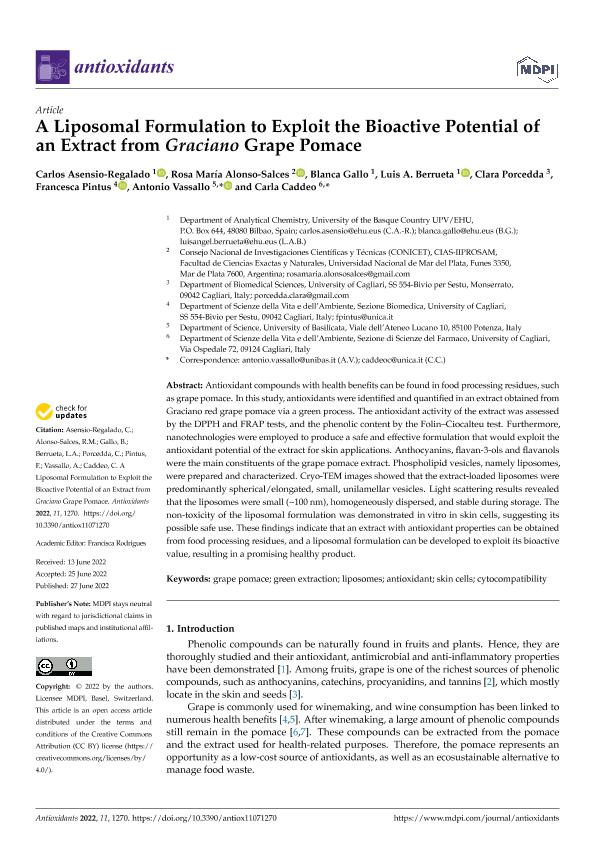Mostrar el registro sencillo del ítem
dc.contributor.author
Asensio Regalado, Carlos
dc.contributor.author
Alonso Salces, Rosa Maria

dc.contributor.author
Gallo, Blanca
dc.contributor.author
Berrueta, Luis A.
dc.contributor.author
Porcedda, Clara
dc.contributor.author
Pintus, Francesca
dc.contributor.author
Vassallo, Antonio
dc.contributor.author
Caddeo, Carla
dc.date.available
2023-09-13T10:48:00Z
dc.date.issued
2022-07
dc.identifier.citation
Asensio Regalado, Carlos; Alonso Salces, Rosa Maria; Gallo, Blanca; Berrueta, Luis A.; Porcedda, Clara; et al.; A Liposomal Formulation to Exploit the Bioactive Potential of an Extract from Graciano Grape Pomace; MDPI; Antioxidants; 11; 7; 7-2022; 1-10
dc.identifier.issn
2076-3921
dc.identifier.uri
http://hdl.handle.net/11336/211307
dc.description.abstract
Antioxidant compounds with health benefits can be found in food processing residues, such as grape pomace. In this study, antioxidants were identified and quantified in an extract obtained from Graciano red grape pomace via a green process. The antioxidant activity of the extract was assessed by the DPPH and FRAP tests, and the phenolic content by the Folin–Ciocalteu test. Furthermore, nanotechnologies were employed to produce a safe and effective formulation that would exploit the antioxidant potential of the extract for skin applications. Anthocyanins, flavan-3-ols and flavanols were the main constituents of the grape pomace extract. Phospholipid vesicles, namely liposomes, were prepared and characterized. Cryo-TEM images showed that the extract-loaded liposomes were predominantly spherical/elongated, small, unilamellar vesicles. Light scattering results revealed that the liposomes were small (~100 nm), homogeneously dispersed, and stable during storage. The non-toxicity of the liposomal formulation was demonstrated in vitro in skin cells, suggesting its possible safe use. These findings indicate that an extract with antioxidant properties can be obtained from food processing residues, and a liposomal formulation can be developed to exploit its bioactive value, resulting in a promising healthy product.
dc.format
application/pdf
dc.language.iso
eng
dc.publisher
MDPI
dc.rights
info:eu-repo/semantics/openAccess
dc.rights.uri
https://creativecommons.org/licenses/by-nc-sa/2.5/ar/
dc.subject
ANTIOXIDANT
dc.subject
CYTOCOMPATIBILITY
dc.subject
GRAPE POMACE
dc.subject
GREEN EXTRACTION
dc.subject
LIPOSOMES
dc.subject
SKIN CELLS
dc.subject.classification
Química Analítica

dc.subject.classification
Ciencias Químicas

dc.subject.classification
CIENCIAS NATURALES Y EXACTAS

dc.title
A Liposomal Formulation to Exploit the Bioactive Potential of an Extract from Graciano Grape Pomace
dc.type
info:eu-repo/semantics/article
dc.type
info:ar-repo/semantics/artículo
dc.type
info:eu-repo/semantics/publishedVersion
dc.date.updated
2023-08-08T12:51:23Z
dc.journal.volume
11
dc.journal.number
7
dc.journal.pagination
1-10
dc.journal.pais
Suiza

dc.description.fil
Fil: Asensio Regalado, Carlos. Universidad del País Vasco; España
dc.description.fil
Fil: Alonso Salces, Rosa Maria. Universidad Nacional de Mar del Plata. Facultad de Ciencias Exactas y Naturales. Instituto de Investigaciones en Sanidad Producción y Ambiente. - Comisión de Investigaciones Científicas de la Provincia de Buenos Aires. Instituto de Investigaciones en Sanidad Producción y Ambiente; Argentina
dc.description.fil
Fil: Gallo, Blanca. Universidad del País Vasco; España
dc.description.fil
Fil: Berrueta, Luis A.. Universidad del País Vasco; España
dc.description.fil
Fil: Porcedda, Clara. Università degli Studi di Cagliari; Italia
dc.description.fil
Fil: Pintus, Francesca. Università degli Studi di Cagliari; Italia
dc.description.fil
Fil: Vassallo, Antonio. Università degli Studi di Cagliari; Italia
dc.description.fil
Fil: Caddeo, Carla. Università degli Studi di Cagliari; Italia
dc.journal.title
Antioxidants
dc.relation.alternativeid
info:eu-repo/semantics/altIdentifier/doi/http://dx.doi.org/10.3390/antiox11071270
Archivos asociados
